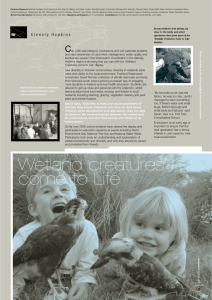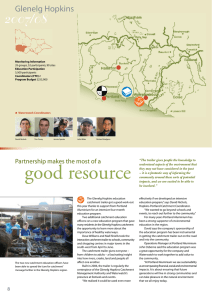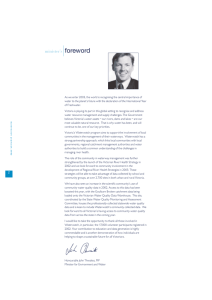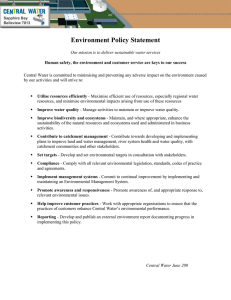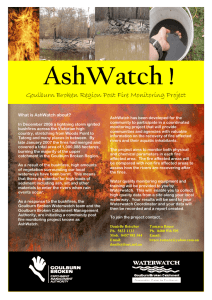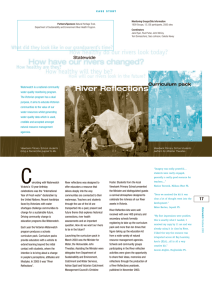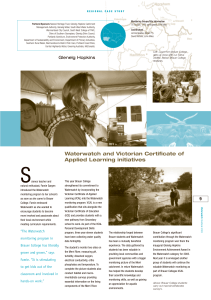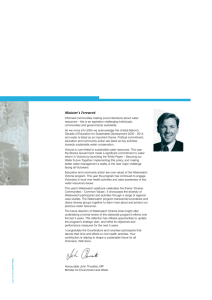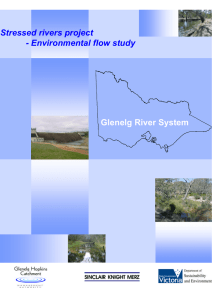2006/07 Glenelg Hopkins
advertisement
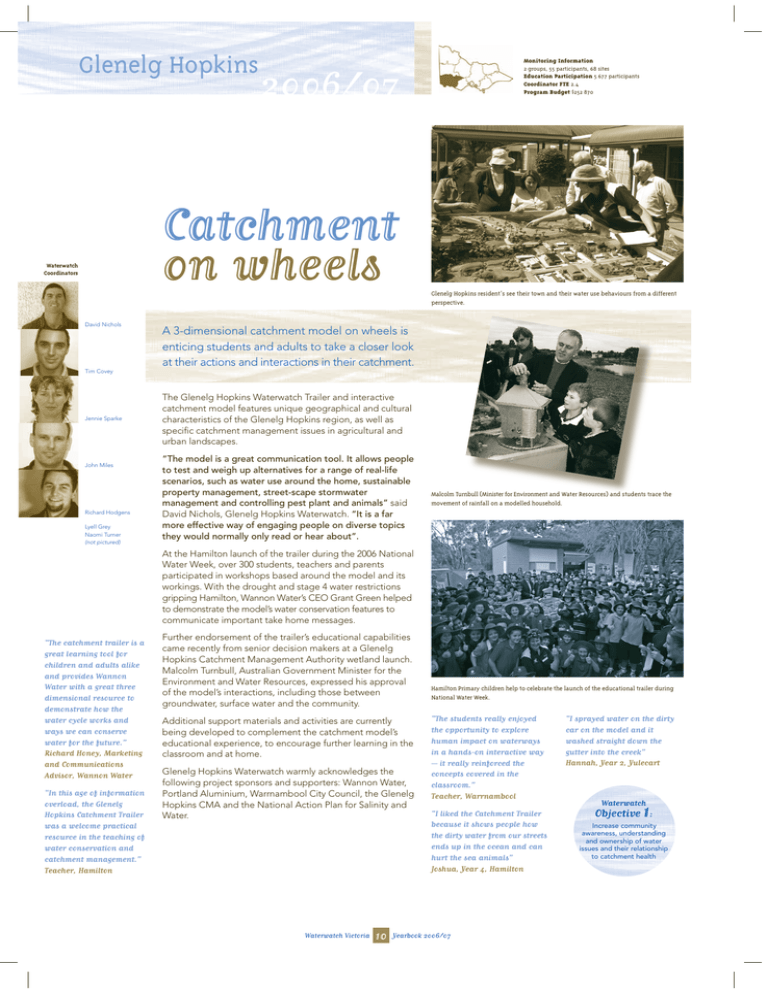
Glenelg Hopkins Monitoring Information 2 groups, 55 participants, 68 sites Education Participation 5 677 participants Coordinator FTE 2.4 Program Budget $252 870 2006/07 Catchment on wheels Waterwatch Coordinators Glenelg Hopkins resident’s see their town and their water use behaviours from a different perspective. David Nichols Tim Covey Jennie Sparke John Miles Richard Hodgens Lyell Grey Naomi Turner (not pictured) A 3-dimensional catchment model on wheels is enticing students and adults to take a closer look at their actions and interactions in their catchment. The Glenelg Hopkins Waterwatch Trailer and interactive catchment model features unique geographical and cultural characteristics of the Glenelg Hopkins region, as well as specific catchment management issues in agricultural and urban landscapes. “The model is a great communication tool. It allows people to test and weigh up alternatives for a range of real-life scenarios, such as water use around the home, sustainable property management, street-scape stormwater management and controlling pest plant and animals” said David Nichols, Glenelg Hopkins Waterwatch. “It is a far more effective way of engaging people on diverse topics they would normally only read or hear about”. Malcolm Turnbull (Minister for Environment and Water Resources) and students trace the movement of rainfall on a modelled household. At the Hamilton launch of the trailer during the 2006 National Water Week, over 300 students, teachers and parents participated in workshops based around the model and its workings. With the drought and stage 4 water restrictions gripping Hamilton, Wannon Water’s CEO Grant Green helped to demonstrate the model’s water conservation features to communicate important take home messages. “The catchment trailer is a great learning tool for children and adults alike and provides Wannon Water with a great three dimensional resource to demonstrate how the water cycle works and ways we can conserve water for the future.” Richard Honey, Marketing and Communications Advisor, Wannon Water “In this age of information overload, the Glenelg Hopkins Catchment Trailer was a welcome practical resource in the teaching of water conservation and catchment management.” Teacher, Hamilton Further endorsement of the trailer’s educational capabilities came recently from senior decision makers at a Glenelg Hopkins Catchment Management Authority wetland launch. Malcolm Turnbull, Australian Government Minister for the Environment and Water Resources, expressed his approval of the model’s interactions, including those between groundwater, surface water and the community. Additional support materials and activities are currently being developed to complement the catchment model’s educational experience, to encourage further learning in the classroom and at home. Glenelg Hopkins Waterwatch warmly acknowledges the following project sponsors and supporters: Wannon Water, Portland Aluminium, Warrnambool City Council, the Glenelg Hopkins CMA and the National Action Plan for Salinity and Water. Waterwatch Victoria 10 Hamilton Primary children help to celebrate the launch of the educational trailer during National Water Week. “The students really enjoyed the opportunity to explore human impact on waterways in a hands-on interactive way – it really reinforced the concepts covered in the classroom.” Teacher, Warrnambool “I sprayed water on the dirty car on the model and it washed straight down the gutter into the creek” Hannah, Year 2, Yulecart “I liked the Catchment Trailer because it shows people how the dirty water from our streets ends up in the ocean and can hurt the sea animals” Joshua, Year 4, Hamilton Objective Yearbook 2006/07 Waterwatch 1: Increase community awareness, understanding and ownership of water issues and their relationship to catchment health A Weed spotters paddle along the Merri River, Warrnambool. W One of Ray Draper’s mates, a Growling Grass Frog. W aterwatch ‘took to the water’ with Warrnambool Coastcare Landcare group to identify emerging riparian and submerged weed problems in the lower part of the Merri River. Watercress (Rorippa nasturtium-aquaticum), a serious and highly invasive aquatic weed, had previously been identified in upstream areas. Fortunately, canoeing participants found no significant weed problems within the river or associated wetlands, but did identify one site with significant litter accumulation. A clean up day in conjunction with Waterwatch and Warrnambool City Council is planned to remove this rubbish. aterwatch data has helped Ray Draper, an environmental consultant and part time Stewardship Officer with Trust for Nature from Ballarat, to target mapping surveys for Growling Grass Frogs (Litoria raniformis) across the Glenelg Hopkins region. The project looked at whether salt is an inhibiting influence to the spread of Chytrid fungus in frogs. This data has helped to identify survey sites of differing salinity concentrations. Waterwatch Objective Objective ‘One farm, where cattle had broken down fences and several died, tested the water at over 25,000Ecs. Farmers learned a great deal about their water sources from this opportunity. Rural supply shop owner. 2 4 Waterwatch 2: Involve communities monitoring their local waterways to collect and provide data which is credible, accepted and used 3: Increase community involvement in water management decisions and gain community commitment to action in addressing waterway and catchment issues Glenelg Hopkins Waterwatch-Department of Primary Industries salinity monitoring initiative has helped land managers to make better management decisions during the drought. Salinity meters were loaned out to six rural supply shops in district centres including Dunkeld, Balmoral and Coleraine. Trained store staff have helped farmers to self-assess nearly 1000 samples – an overwhelming response. Leaflets on salinity tolerances of animals, groundwater permits, blue-green algae in dams, agency contact details and other farm management issues were available to inform farmers’ decision making. 1 Access to salinity monitoring equipment has been helpful for drought-affected farmers. Waterwatch 5 3 O ver 150 Waterwatching school students extended their catchment studies to a deeper, cultural level at the Tyrendarra Cultural and Environmental Day near Lake Condah. Students presented on a range of topics on the Victorian Volcanic Plains environment. These were complemented with interactive wildlife demonstrations and hands-on indigenous painting, dance and site tours of this significant cultural site. The day acted to connect local students to their shared heritage and environment. Students learn about indigenous fish traps. (Photo courtesy of Matthew Butt) Waterwatch Objective 5: Provide school learning opportunities and be an integral part of the curriculum Objective 4: Establish and maintain effective partnerships between the community and catchment managers Other outstanding highlights and achievements Waterwatch trailer and catchment model launched. Waterwatching school Hawkesdale P-12 – winner of Glenelg Hopkins CMA Award (education category) 400 kids participated in Waterwatch activities during World Environment Day celebrations. Partners/Sponsors National Action Plan for Salinity and Water Quality, Glenelg Hopkins Catchment Management Authority, Environmental Protection Authority, Portland Aluminium, Wannon Water, Greening Australia, DPI Fisheries, Fishcare, Coastcare/ CoastAction, Warrnambool City Council, Moyne Shire Council, Southern Grampians Shire Council, Waste Reduction Group. Photos courtesy of Glenelg Hopkins Waterwatch and Glenelg Hopkins Catchment Management Authority (unless otherwise stated). Waterwatch Victoria 11 Yearbook 2006/07
